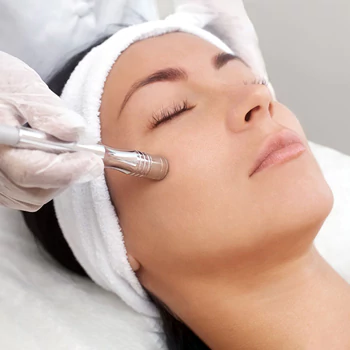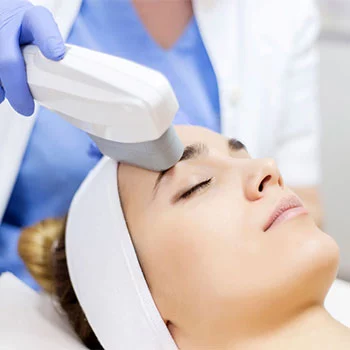What is microneedling?
Microneedling is taking the beauty industry by storm for good reasons. It is an anti-aging procedure that is used for many skin issues such as wrinkles, aging spots, and scars that have not responded well to other treatment options. Microneedling was invented in 1995 for scar treatment but over the years it was modified multiple times to become what it is today.
The procedure utilizes a device with fine needles to prick the skin. There are different brands of microneedling devices, which are different in how they puncture the skin. The most widely known devices are DermaRoller, DermaStamp, DermaPen, and DermaFrac, whose names imply the way they prick the skin.
DermaRoller is the most typical microneedling device and that is why the treatment is sometimes called dermaroller procedure.
DermaRoller has a cylinder with tiny needles that is rolled on your skin. DermaStamp is similar to a stamp with a flat surface containing needles that is stabbed at the skin. DermaPen is an automated device that has a round tip containing micro-needles with vibrating movements. DermaFrac is the most recent innovation that combines microneedling with microdermabrasion, serum infusion, and light-emitting diode (LED) therapy to target aging spots and wrinkles.
The length of the needles ranges from 0.5 to 2.5 millimeters while the diameter is between 0.1 and 0.25 mm. The shorter ones only penetrate the top layer of your skin but longer needles can reach deeper layers. In either case, the micro-punctures will not be visible after the procedure.
The size of the needle will be selected based on the expected outcome. For example, 1.5-2 mm is used for treating acne and other scars while 0.5-1.0 mm is used for aging skin and wrinkles. Needle size also determines the length of intervals as longer ones require longer recovery times.
The procedure must be performed by a board-certified dermatologist, plastic surgeon, or cosmetic surgeon in a sterilized environment since your skin will be vulnerable to infection. A licensed aesthetician might also be permitted to perform the procedure depending on the regulations in your location. However, supervision by a physician might be required.
The procedure is approved by the FDA for facial acne scars, facial wrinkles, and abdominal scars in patients older than 22 years and only in certified offices. Over-the-counter sale of devices is not authorized as they are considered medical devices.
How does microneedling work?
The main concept behind this procedure is that micro-injuries can force the skin to rebuild itself by producing collagen, elastin, and new tissue. That is why it is called collagen induction therapy. By pricking the top layer of the skin with microneedles without damaging the epidermis, you are encouraging the growth of new skin that is younger and more supple because the natural healing process will be initiated and growth factors (GFs) will be released.
A study on 480 patients from South Africa and Germany who had lax skin, fine wrinkles, scarring, and stretch marks showed a considerable increase in collagen and elastin deposition 6 months after microneedling and 40% thickening of epidermis 1 year after the treatment, resulting in visibly tighter and smoother skin.
In the case of microneedling radiofrequency (MNRF), it uses devices that deliver radiofrequency (RF) energy to treat facial wrinkles and loose skin. The currents are released from needle tips that generate thermal zones in the dermal structure without damaging the epidermis. These devices are approved by the FDA.
What are the benefits of microneedling?
Microneedling is used to address many skin issues such as:
- Age spots (liver spots, sun spots)
- Fine lines and wrinkles
- Loose skin
- Large pores
- Hyperpigmentation
- Under-eyes dark circles
- Eye bags
- Scars
- Acne scars
- Varicella (chickenpox)
- Cellulite
- Stretch marks
- Alopecia
Stretch marks on the abdominal area and cellulite on the thighs can respond well to this treatment. The resulting skin will look smooth, firm, bright, and youthful. It is potentially beneficial for hair growth on the scalp or face too but more research is needed to determine how effective is microneedling in treating hair loss.
Microneedling improves these problems by:
- Accelerating healing process
- Increasing collagen production
- Enhancing elasticity
- Maximizing firmness and thickness
- Brightening the tone and glow
- Improving evenness in tone and texture
Sometimes, microneedling is combined with other treatments such as PRP (platelet-rich plasma) injection, fillers, stem cells and even topicals like hyaluronic acid, 5-aminolevulinic acid, Niacinamide, topical tretinoin and vitamin C to maximize benefits as the skin can absorb more nutrients or therapeutic drugs. It has even been used on the scalp in combination with minoxidil and triamcinolone acetonide to treat alopecia.
How it’s done
Preparation
The treatment starts with your doctor explaining the expected outcomes, the number of sessions you would need, and potential side effects. You will be asked about your current health status and the medications you are taking. You might be advised to stop taking certain medications such as ibuprofen or acne treatments to prevent complications.
You might also need to stop applying topical retinoids to reduce side effects. Your doctor may also ask you to avoid hair removal treatments such as laser hair removal, electrolysis, waxing, and hair removal creams two weeks before your microneedling. Be sure to inform your doctor if you have an allergy or sensitivity to topical numbing agents.
Depending on your skin quality, the doctor might prescribe vitamin A and C to prepare it for the procedure one month in advance. This will maximize dermal collagen formation and new tissue generation.
Procedure
A typical session of microneedling treatment takes about 30 minutes to complete, but it generally depends on the area and problems that are to be treated. Your doctor starts the procedure by numbing your skin with a topical anesthetic to prevent possible pain. Antiseptic and saline may also be applied to prevent infection.
The doctor will use a new needle cartridge and move the device evenly in multiple directions across your face to achieve an even result. Each area will be rolled 5 times until a uniformed pin-point bleeding is observed across your face. Saline, ice packs, or a calming serum might be used post-procedure to clean and calm the skin.
What is the recovery like?
You can resume your everyday routine immediately after the procedure unless advised otherwise by your doctor. There is no downtime to this therapy. However, you will be advised to avoid certain situations such as direct sun exposure because your skin is too sensitive. Any activity that causes excessive sweating or heat is not recommended, so you should avoid the gym and hot yoga.
Attending a swimming pool, sauna, or washing your skin should also be avoided for the day. Harsh soaps and cleansers are not recommended or any products that contain retinol, menthol, glycolic acid, capsaicin, and alcohol. Makeup products are not recommended either for the day.
Microneedling results will surface after a couple of weeks. But to maintain it, you might need several sessions (at least 4) based on your circumstances at 4 to 8-week intervals.
How does microneedling vs at-home dermarolling work?
Professional microneedling is often compared to at-home dermarollers by patients but the benefits of in-office microneedling are far beyond. Home rollers do not have long needles and so they don't prick your skin deeply, which is the main point of rejuvenation in microneedling. With at-home dermarolling, you might achieve a brighter tone but you miss the skin qualities of youthfulness and evenness in tone and texture, which you only get from in-clinic microneedling.
Is there any micro-needling side effect?
Your skin will naturally respond to the treatment with redness and irritation to generate collagen and elastin, which will last for a few days only.
Severe side effects such as infection, bleeding, bruising, and peeling may also occur but they are rare. In such cases, you must contact your doctor immediately.
Who is the ideal candidate for microneedling therapy?
Anyone with good health can consider this treatment and achieve great results. However, this treatment is not recommended for pregnant women.
People with active skin issues such as eczema, psoriasis, rosacea, keloids, perioral dermatitis, acne, and open wounds are not good candidates for microneedling. Those who take blood-thinning medicines are also advised to avoid this procedure to prevent excessive bleeding. Even recent radiation therapy can influence the results.
How much does microneedling cost?
The cost of microneedling depends on the size of the area being treated. It ranges from $100 to $700 for each session with the facial microneedling averaging around $300.
Since microneedling is a cosmetic procedure, there is no insurance coverage but some doctors might offer a payment plan or even financing.
Closing words
Microneedling is a rejuvenating treatment that makes your skin younger, plumper, brighter, and smoother if performed by a board-certified doctor. The results are due to a 40% increase in collagen and elastin production which are often lost in the aging process. Considering the huge benefits, low risks, minimal invasiveness, and reasonable cost, skin needling therapy is definitely worth the effort.



